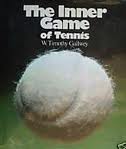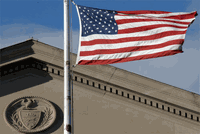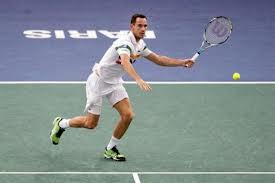The Inner Game started it all

The Inner Game by W. Timothy Gallwey was a big book when I was young. It was a mix of the tennis man's bible, that is, his set of codes and beliefs, but also a coaching manual.
The amazing thing is that the book typified a time. This was a period when the USA, and American things in general, dominated our thnking on everything. You could argue that today has very much the same scenario, but our attitude towards the USA has become much more tempered in recent years, a consequence of financial dereputation, and the diminishing role of the USA, relatively in politics and the social world. The USA has lost some of its desirability value.

American Desirability
The Inner Game is therefore very much an American book, one fired by an American spirit. I've never been to the USA, but I've worked with so many Americans that I feel I know the place. The American spirit is much more than the "land of opportunity" , as it has so often been portrayed. It is also the land of world policing and discipline, a religious agenda that pervades politics and the media, and the power of money, and in particular locking into people's greed and desperation for a chance to prove themselves and acquire riches. The Inner Game bears so much of this - a yoga-like attitude to life, but one where you are nevertheless striving for perfection and success. This is the American spirit, and I've got to say, it is very appealing. It suggests that you can keep your life racing forwards, just by regulating your own mind and attitude. It sounds so so easy.
The Inner Game is therefore a book of belief, of self-belief. That is its essential addition to the world of tennis. It opened up an easy-to-understand dimension of learning a game, but in fact anything.
However, it is a coaching manual too, but very different from anything we had seen before.

Certified
I took my first tennis teaching certificate courtesy of the British Lawn Tennis Association in 1981. I was already tennis mad by this stage, but extremely inexperienced. I was clueless about technique and teaching methods. The LTA course was a terrible disappointment, such that it steeled me to emigrate, to distance myself as far as possible from all things to do with it. Quite simply, the LTA coaching manual, I think similar to many other coaching manuals in the world, felt that pieces of a tennis swing had to be put together on a step by step basis. That is, my coaching course told me, "get your racket back"! And if you didn't "get your racket back", you'd fail, regardless of how well you carried out the rest of the steps. Just for trhe record, not only is this instruction totally incorrect, it incites fear and dictatorial thinking, and these are also forbidden in my teaching world.

Confusion
The Inner Game interestingly came from another sport - golf, very much a game of inner control with no opponent to worry about. Then it was applied with a bit of tweaking to tennis, and claimed it could be used for all sports. Mr. Gallwey was right, because taken purely as a code of beliefs, a life attitude to a sport, his book serves a real purpose. In the book there are a few tennis photos, but the coaching side of the book is still very fixed on the "inner" aspect of coaching, the images and visualisation that we create inside us, irrespective of what instructions our coaches, or even we ourselves tell us to do. The image is everything.
If we want to create that shape on the ball, say a high looping topspin, then first we must visualise it, then we must "let" it happen. We must trust the body, the mechanical bits, to sort it out. You do need a smattering of technical knowledge to put this in place. An Inner Game teacher will show you a shape on the racket swing, that you must copy, let's call it a loop. Forget the "racket back" scenario. It doesn't matter how you get that racket into position, the most important thing is to control how YOU want the racket to shape through the ball. It is all very arty, and extremely appeallling. Especially for a desperately disappointed young player wanting to get involved in coaching as I was.
This ground-breaking book told us to throw away the instruction manual, and, through our own mind control, deliver basic mechanics onto a ball. It seemed to make life easy.

Mind control
I'm going to disappoint all of you retro tennis fans. I cannot recommend the book. This book did create a first. It made us think differently about tennis, and indeed about lifestyle. But ultimately The Inner Game achieved for me almost as much as the LTA course did. I still didn't know how to do it.
It wasn't until 1986 when I did my USPTR course that the last pieces of the jigsaw were put in place. The USPTR incorporated some elements of the inner game, by dedicating a whole manual to mental control, in fact a tennis users guide to meditation, which did pretty much the same job as The Inner Game. The USPTR went back to the old step-by-step coaching manuals, and with great help from video, and body mechanics, or physiology, identified exactly what parts of the shot had to be in place in what order. On the forehand there are four parts, on the backhand, three, on the volley and drop shot - one, and on the serve - four. I can honestly say if you can learn 12 steps in order, you can play tennis.

Run-in volley
The "let" aspect of the mechanics is still a major feature, but is tempered by the fact that, very early on in the USPTR learning process, you must compete. That is, you must test your steps under pressure. None of anything you ever learn is any good unless you can do it under pressure. In my very short USPTR course I had learned everything I needed to know, and 25 years later not much has changed.
The Inner Game allowed the old school teachers to be blown away - the bullying and fear. It allowed science, technology and visualisation to be considered, without really indicating how to use these together. It was an essential breakthrough.
Have A Great Story About This Topic?
Do you have a great story about this? Share it!



